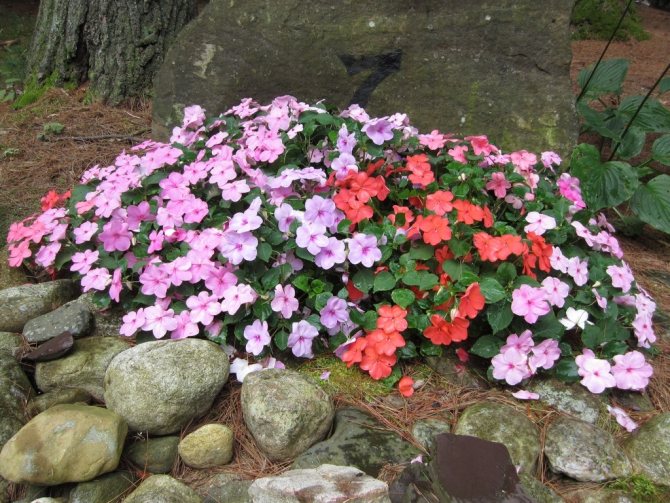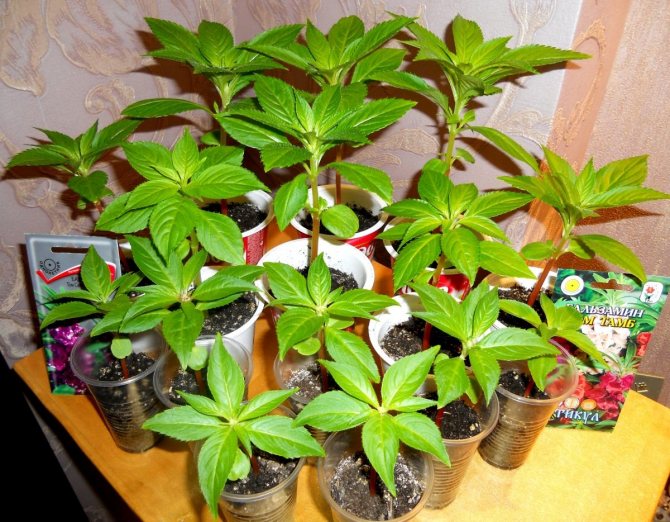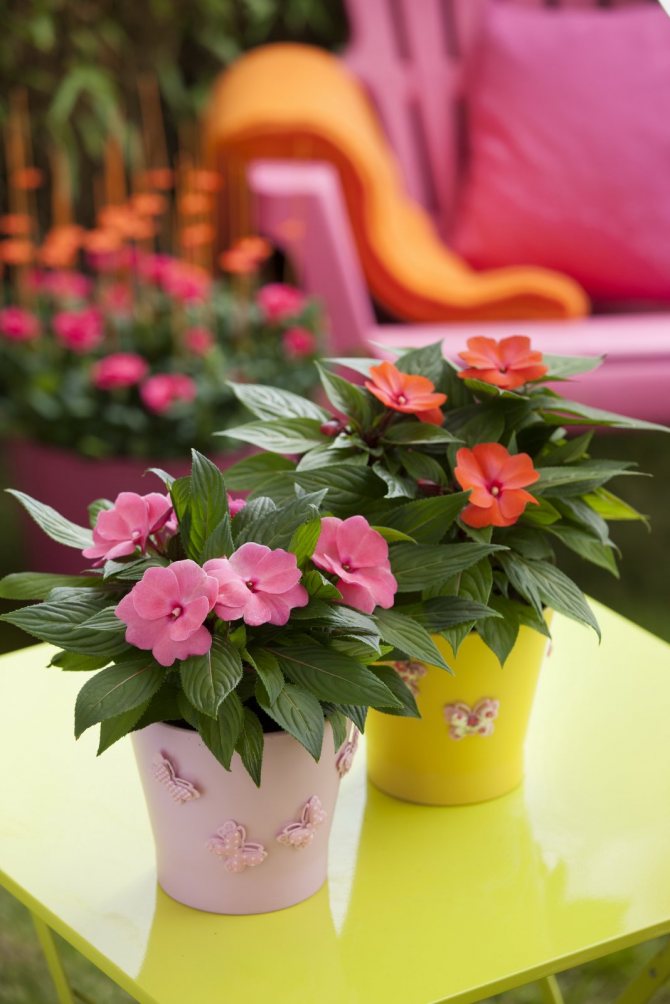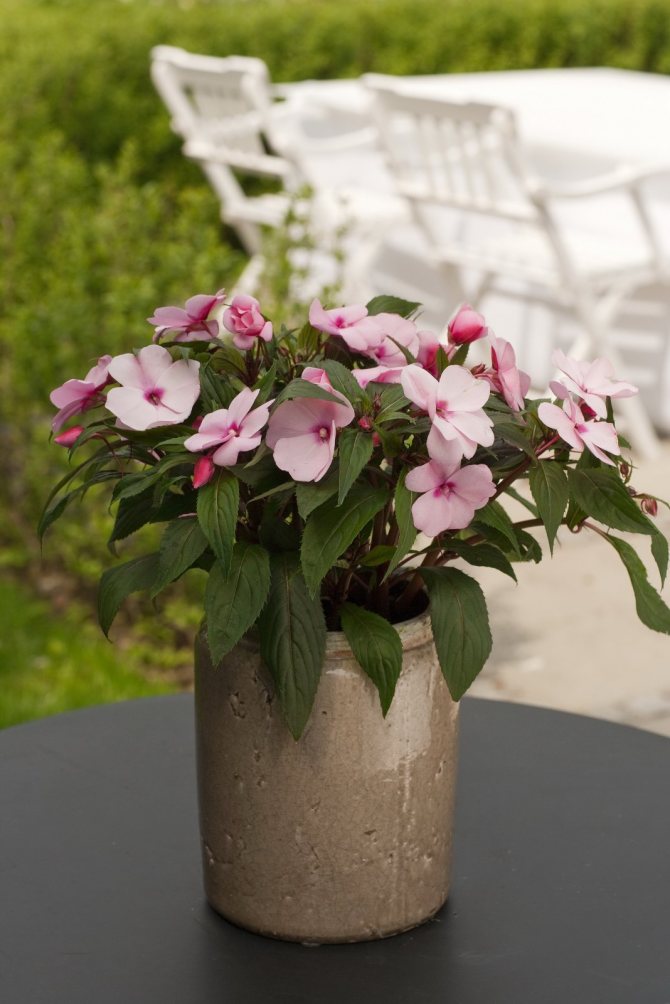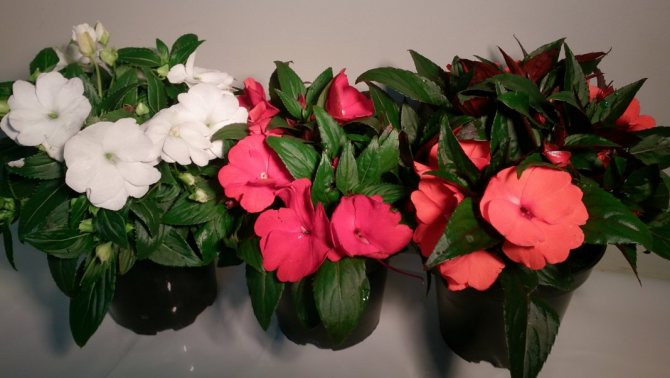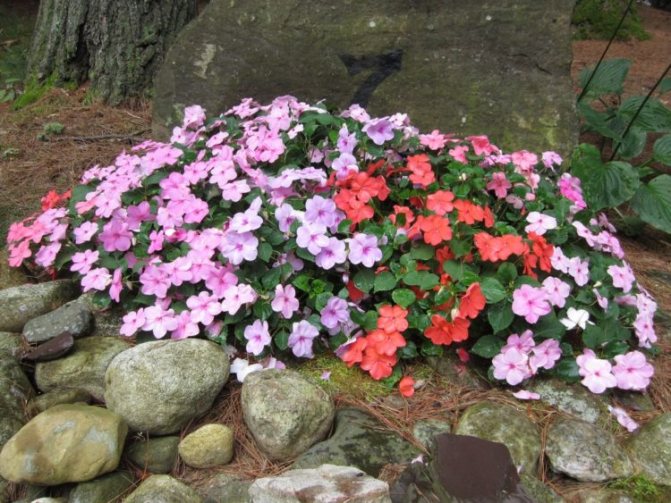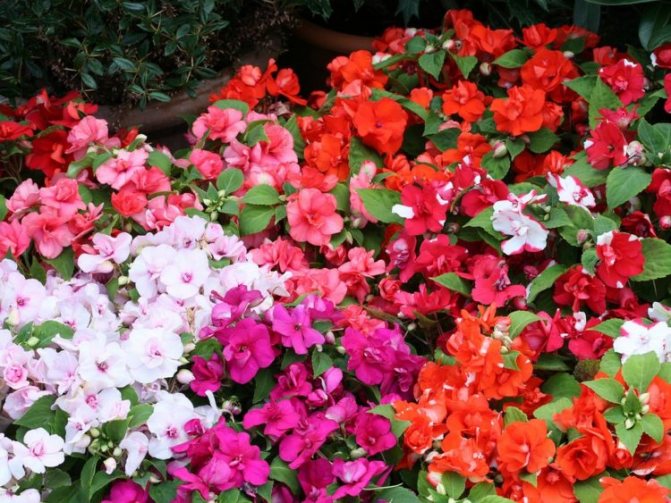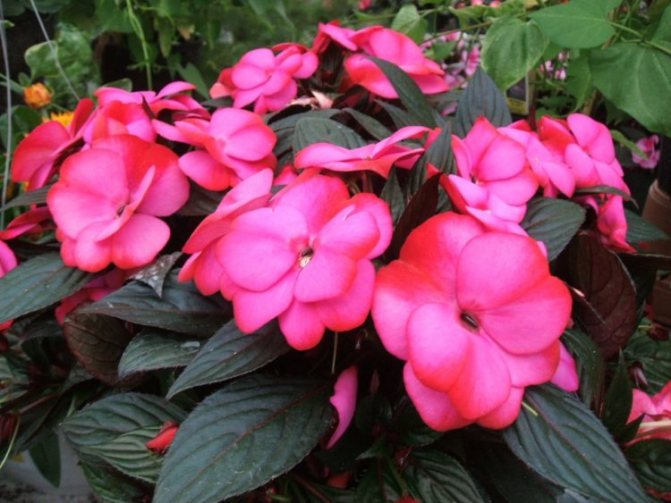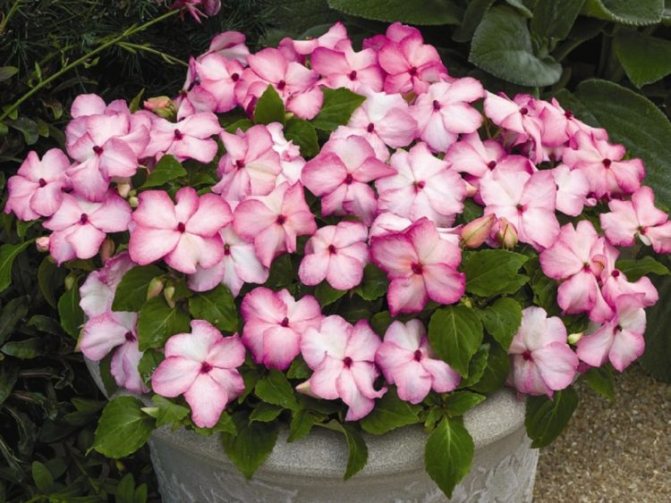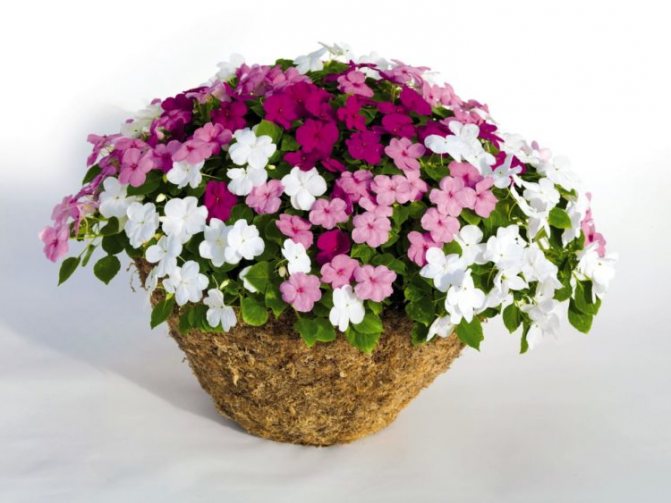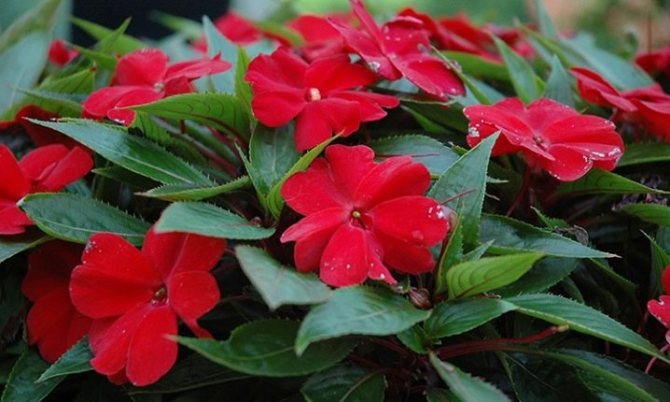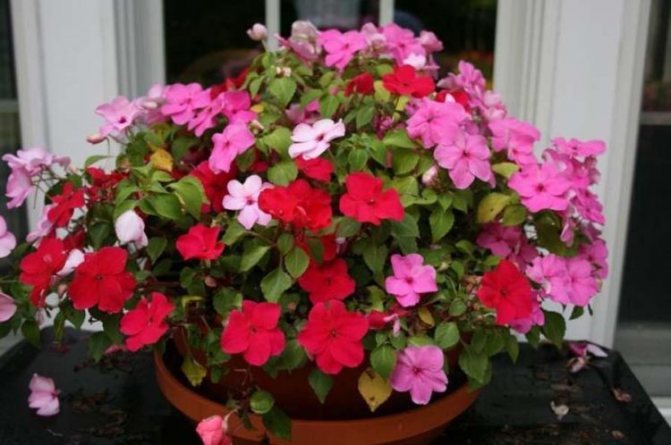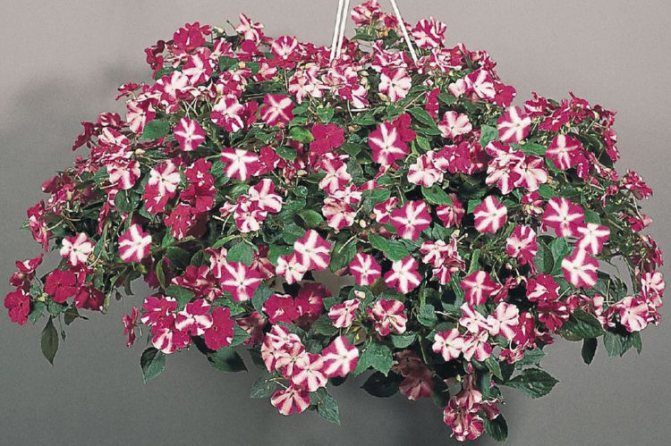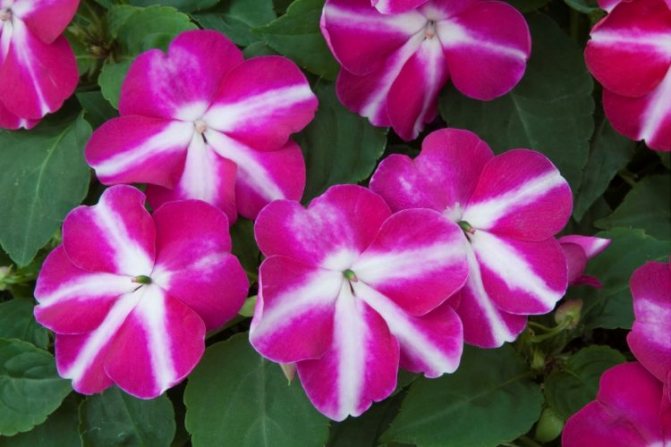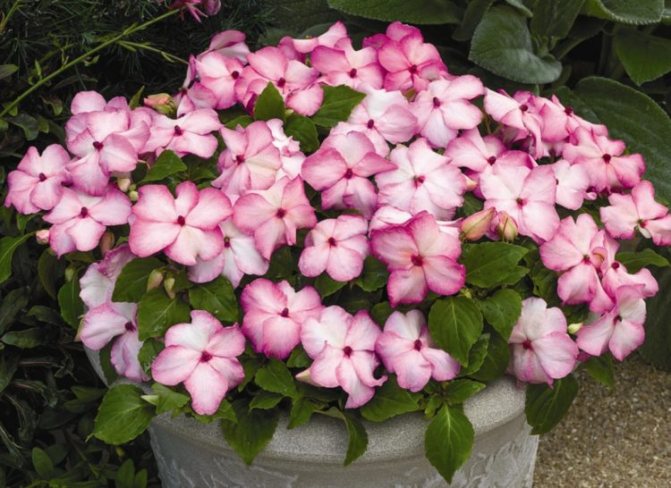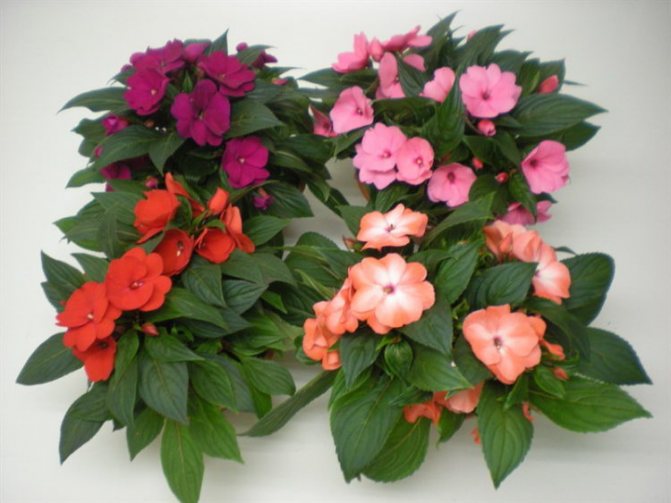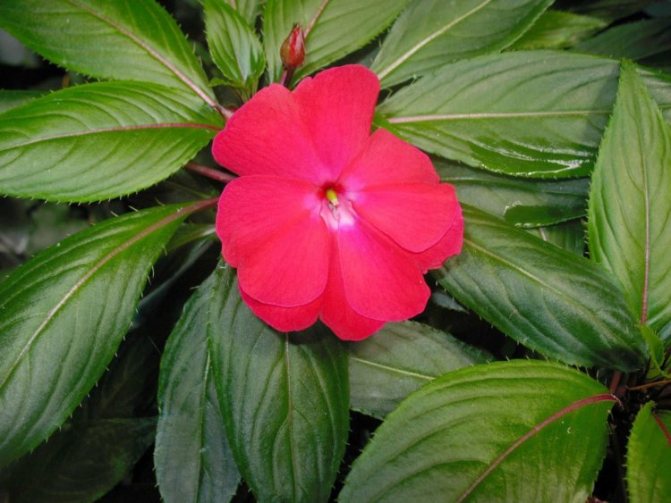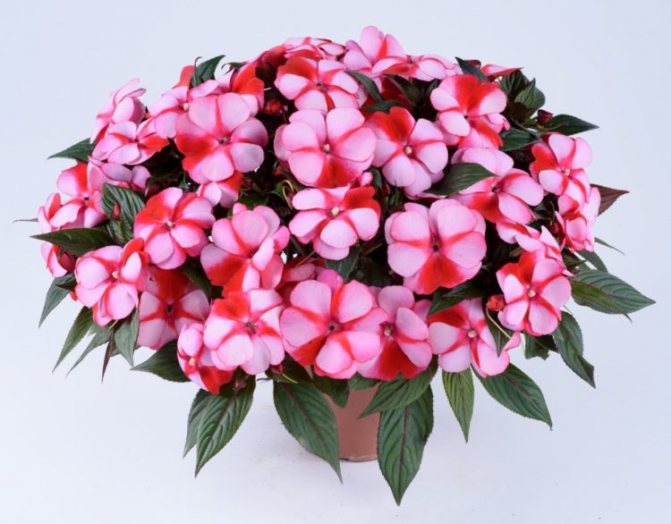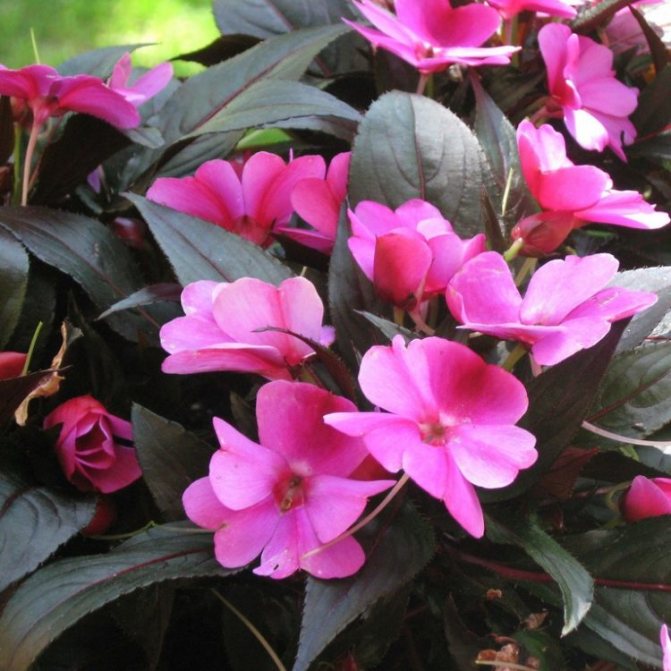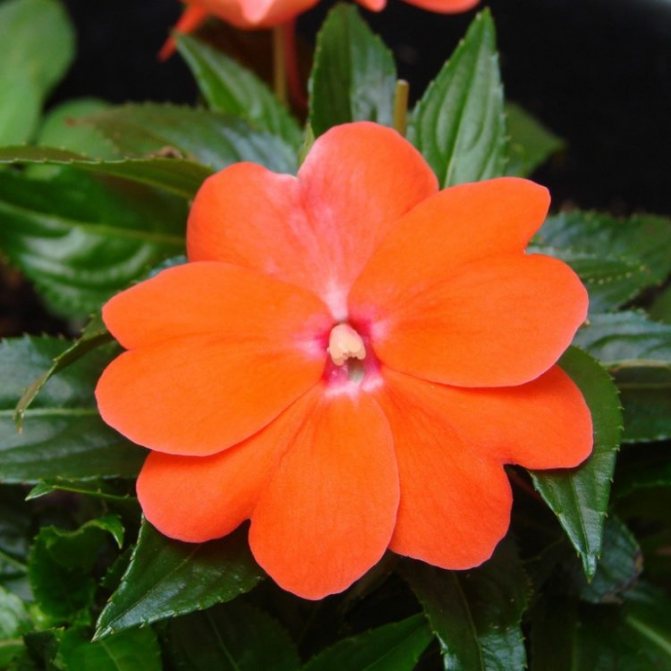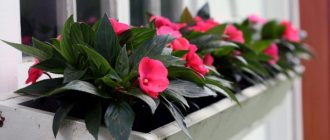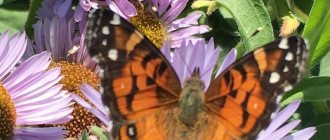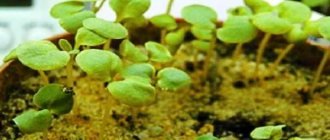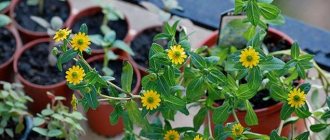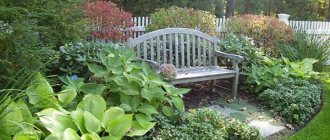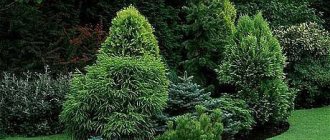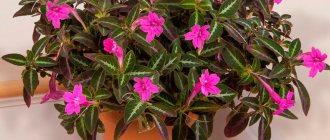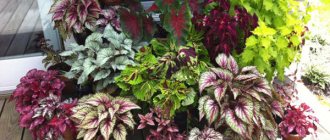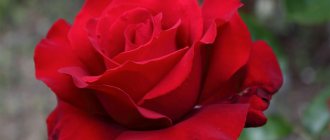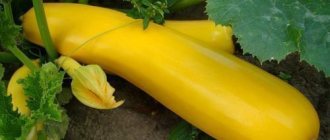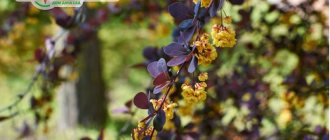With the increase in the number of Western plants on our market, in particular, varieties of Dutch selection, the idea of the balsams we are used to has changed dramatically. So, the status of an exotic novelty was changed to the title of favorite by New Guinea balsam hybrids, bred specifically for more spectacular flowering. There are many secrets and subtleties in the cultivation of such balsams, on which the splendor, and the attractiveness of greenery, and the duration of the period of preservation of decorativeness depend. The Guineans cannot be called difficult to leave, but they require a special approach to themselves.
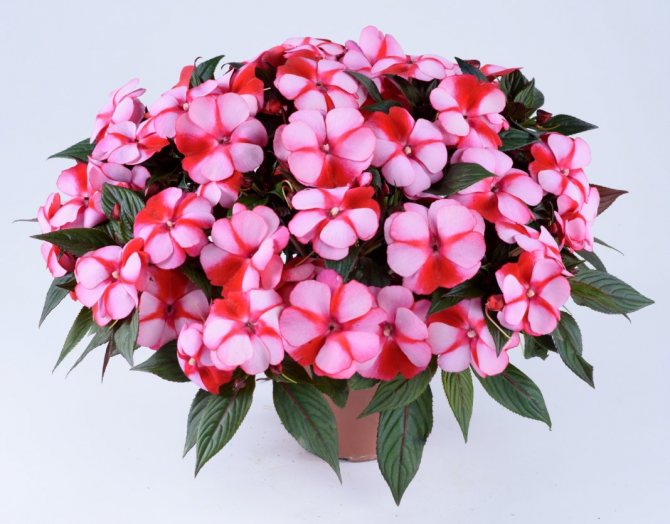
Balsam New Guinea Harmony Series Strawberry Cream
Homeland
The genus Impatiens, which can be translated as "untouchable" or "touchy", is the basis of the Balsamic family and consists of half a thousand species that grow all over the planet.
Due to the prevalence and variety of plants, it is impossible to indicate the exact place on the map, worthy of being called the birthplace of balsam plants. They are found throughout the world in temperate and tropical regions, but there are several main centers of concentration of the species. These are, first of all, Asia and African countries, North America and Europe.
The acquaintance of botanists with touch-sensitives began in the 17th century. The first information about plants of this genus dates back to 1689 and contains descriptions of some varieties of balsam from India and nearby regions of Asia. Then Karl Linnaeus took up the study of plants, to him the growers owe the most complete description and systematization of numerous species.
The most famous species in our country is Waller's indoor balsam, which grows in the wild off the east coast of Africa in the Zanzibar archipelago.
It was here that new plants for botanists were discovered in 1861. Several copies, originally named after the local ruler, were shipped to Europe by the British naturalist John Kirk. Here, the attentiveness of the English missionary Horace Waller, who first noticed the unknown plant, and his find were appreciated. And the African touch-me-not got the name Impatiens walleriana in 1896.
The plant fell in love with the inhabitants of many countries. Today, the continuously blooming indoor balsam in the West is often called Busy Lizzie, and in Russia the culture is called the Vanka Mokryi light. Such an unusual, even familiar name is explained by the peculiarity of the plant, which forms small droplets of sweet liquid on the leaves, which eventually turn into hard sugar balls.
Among the garden balsams, in the photo, stands out Impatiens balsamina - a small but very attractive native of South Asia, decorating flower beds and borders in many regions of Russia.
In the 20th century, growers were able to get acquainted with an extensive group of hybrids from New Guinea. Now these exotic plants are available to collectors and indoor crop lovers, and some varieties in mid-latitudes have felt so comfortable that they have become real weeds, displacing native species from their usual places.
This fully applies to the Himalayan balsam, which a hundred years ago was found only in its homeland.
Among the hard-to-reach or, as they are used to call them in Russia, balsams are wild, garden and home crops.Annual plants in the middle lane are grown as garden balsams, and indoor varieties are crops whose growing season lasts for several years.
Thanks to the active selection work begun in the middle of the last century and the popularization of unpretentious, willingly flowering species, balsams have taken a worthy place in the collections of flower growers.
Moreover, they are so different from each other in the shape and color of flowers, sizes and habitats that it is difficult to even suspect representatives of different species of belonging to the same genus. Among the balsams are:
- herbaceous annuals and perennials that look like small trees or dwarf shrubs;
- dwarfs no higher than 20 cm and giants 2 meters in height;
- frost-resistant and accustomed to living only in warm tropical climates.
Therefore, the answer to the question: "What do balsams look like?" cannot be simple and monosyllabic.
But with a lot of differences, balsams from different parts of the world have a lot in common. Plants are called touchy because of the peculiarity inherent in many species. The slightest touch to the juicy fruit-box causes its instant disclosure, and the contents scatter with tremendous force over a distance of several meters.
In the plant world, balsams are considered to be a kind of record holders for the variety of shapes and colors of corollas.
The flowers of indoor balsam and its garden counterparts can be simple and double, monochromatic and two-colored, with a bright contrasting center or a scattering of spots on the petals.
The average flower diameter of indoor balsam is 2–4 cm, but there are also plants that delight owners with larger corollas of bright colors. A characteristic feature of the balsam flower is a thin curved spur, but the shape and size of the petals can be different:
- Waller's room balsam has flattened corollas, and the petals that make up them are almost the same.
- In other varieties, due to the shortened asymmetric petals, the flowers more resemble violets or snapdragons.
This diversity is associated with different plant habitats and which insects are involved in pollination.
The vast majority of indoor and garden balsams love shade, there are few exceptions to this rule. First of all, these are plants from New Guinea and, for example, the wild-growing balsam glandulifera. But moisture is vital for all touch-sensitives, but moisture-loving species have to protect flowers and leaves from an excess of water.
Smooth lanceolate leaves of balsams do not differ in richness of forms, but can have both monochromatic and variegated colors. Interestingly, thanks to a special coating, the surface of the leaf plate, drops roll off it, and the leaf remains dry even in heavy rain. The underside is protected from getting wet and rotting by a mass of tiny air bubbles trapped between the villi.
The flowers are protected from dew and rain by the pedicels lengthening as the corolla opens. As a result, the flower of the garden balsam, as in the photo, bends, and the streams of water cannot wash off the ripe pollen.
New Guinea Balsam comes from the tropics of West Africa. It got its name from its parent Hawkeri Balsamin, who was discovered by Lieutenant John Hawker in Papua New Guinea. Almost 100 years later, scientists crossed the find with several other species and got a wonderful hybrid.
Features of the
In balsams, jagged or oval leaves of a wide variety of green shades are distinguished. The fruit consists of a polyspermous capsule. If you touch it with your hand, it will instantly open and the seeds will fall out.
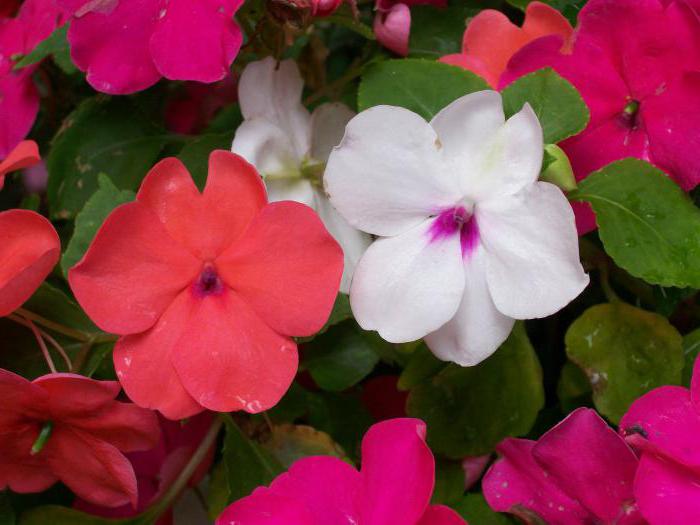

Balsams have a wide palette of colors. There are representatives with bright red, purple-pink flowers, monochromatic or multi-colored.For example, double and semi-double flowers reproduce the shape of a camellia, carnation or rose. In addition, in one group, you can find buds with different degrees of development: open, unblown and withered. Hybrids of carmine, red and purple-pink shades are widespread.
The plant grows well in moist fertile soils. Initially, balsam was popular in tropical Africa, India, China, and then it spread throughout the Northern Hemisphere.
The history of the discovery and study of balsams
New Guinea balsams originated in Africa. They got their distribution in 1972. It is used to decorate balconies, windows and loggias. One of the youngest species that has gained popularity in Russia. The balsam plant is unpretentious, but you should take care of the flower correctly, since in unfavorable conditions the plant does not bloom, but sometimes it even dies.
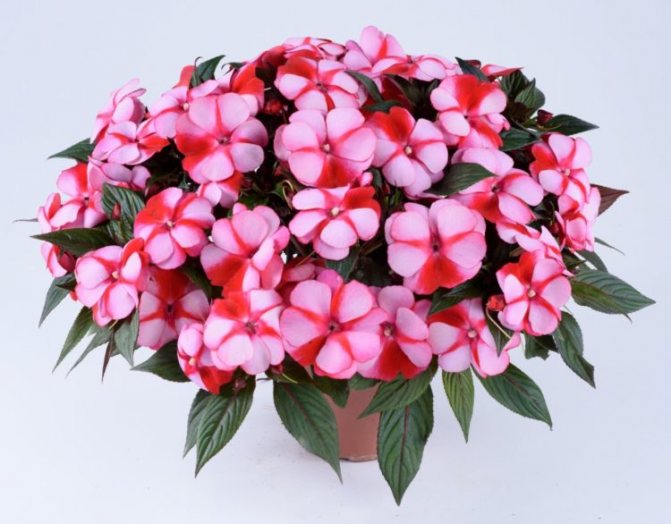

Due to the work of breeders, we have various types of colors, as well as continuous flowering properties. Balsam is a houseplant with beautiful flowers and beautiful decorative leaves. It grows no more than 40-50 centimeters, has rather brittle stems. Pointed leaves with jagged edges are a characteristic feature of the species.
Depending on the variety, the leaves can have a different shade. Usually the flowers are reddish. This type of balsam is unlike others with a strong stem, the presence of a more compact bush, large flowers and leaves. In the garden, they are used to decorate hanging baskets, since the bright and beautiful spots of plants attract the eye.
This is a fairly hardy plant that does not require particularly careful care, so the answer to the question "can it be planted in the garden", the answer is yes. And yet, more often, New Guinea balsam is grown in the room, because it is here that it will delight you with flowers all year round.
The genus of balsams has many annuals and perennials, herbaceous or shrubs, reaching a height of 25-200 cm.
The stems of balsam are branched and smooth. At the places of branching, the stems are swollen. The shade of the stems ranges from light and bright green to dark and purple hues.
The leaves of the plant, as a rule, are simple, arranged alternately or oppositely, and there are many of them on the stems. Sometimes at the top of the stem, they gather in whorls. Each leaf has a diameter of no more than 12 cm. Their shape is oval, heart-shaped, ovate or lanceolate, with long or short petioles. At the edges, the leaves are serrate, serrated or whole.
Flowers are either regular or irregular. Their diameter ranges from 3 to 5 cm. Shades of flowers are different, about 15 of them, for example, white, pink. Red balsam is also common. The flower petals are simple in shape. The flowers have a double cup, with five sepals. The corolla petals have grown together in pairs, and the unpaired fifth one grows near the spur.
Each flower has five stamens. They are terry, more often solitary, but they are collected in loose umbrellas of inflorescences, in which there are from 2 to 15 flowers. Buds of flowers develop in the axils of the leaves, have short pedicels. Gradually, the pedicels become longer as the flowers develop. Flowers are pollinated with the help of raindrops rolling down the plate of leaves. At the time of flowering, blossoming flowers on pedicels rise above the foliage.
The roots are located near the surface of the soil, often fibrous, very strong. Some varieties of balsam have a very "branched" rhizome.
The fruit is a juicy fleshy capsule containing many spindle-shaped seeds. When the fruit is ripe, the capsules open easily if you touch it. Five twisted leaves scatter seeds far, not less than two meters.
www.glav-
Balsam is a perennial ornamental herb that belongs to the balsam family. In the people, this flower has acquired the name "touchy". This is due to the fact that the fruits of balsam, containing seeds inside, burst when ripe when lightly touched. On the territory of Russia and Europe, the hybrid variety New Guinea balsam is valued for its large and beautiful flowers and compactness of the bush, subject to constant pruning and care. The native land of the species is the tropical and subtropical forests of America, Asia and Africa.
Features of the structure:
- In height, the plant, depending on the variety and place of growth, can reach from 30 to 50 cm.
- It has a strong root system that grows and branches well.
- Balsam New Guinea grows in the form of a bush with good branching of the stems, which, unlike other species, have a complete and strong structure.
- Leaves are densely located at the tops. They have an oblong oval shape, sharpened to the ends. The edges are serrate, the veins are pronounced, the petioles are short. The color of the leaves ranges from light green and green to brownish red.
- The flowers are large, can reach 5-7 cm in diameter. The petals are curly, have lateral elongated outgrowths, their color depends on the variety and can be monochromatic or two-color with patterns. The buds are located on the tops of the stems, one or more in the inflorescence.
The flowering period is long and, depending on the place of growth and climatic conditions, can last for several months. For potted indoor balsam representatives, this period can last up to 10 months.
They represent an oblong box, the outer part of which is divided by several ribs. After ripening, the fruit opens with the first touch and at the same time throws out the seeds. Thus, the plant reproduces in nature.
Popular varieties with photos
The most common varieties and varieties of balsam include:
- Garden balsam;
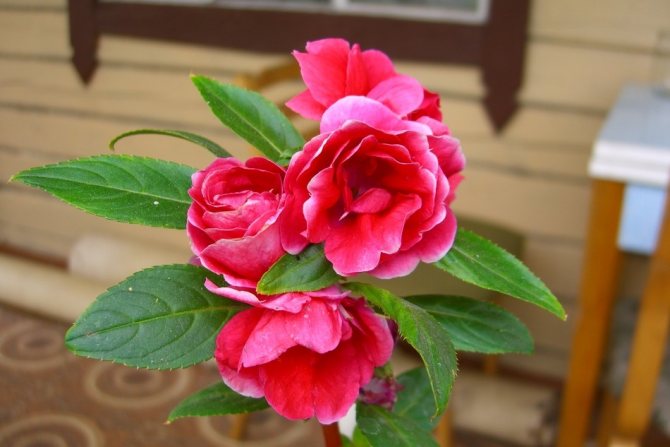

- Ampelous balsam;
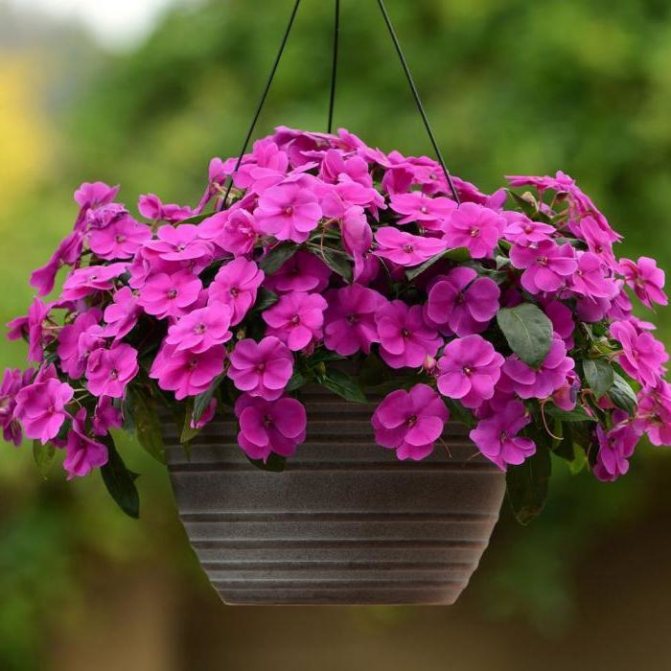

- Dwarf balsam;
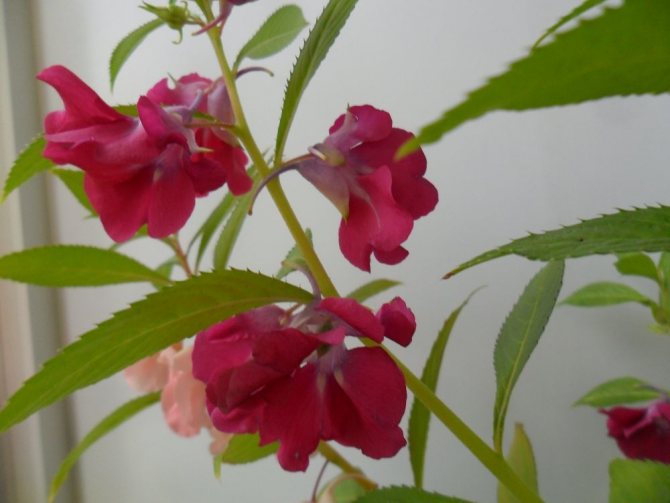

- Terry balsam;
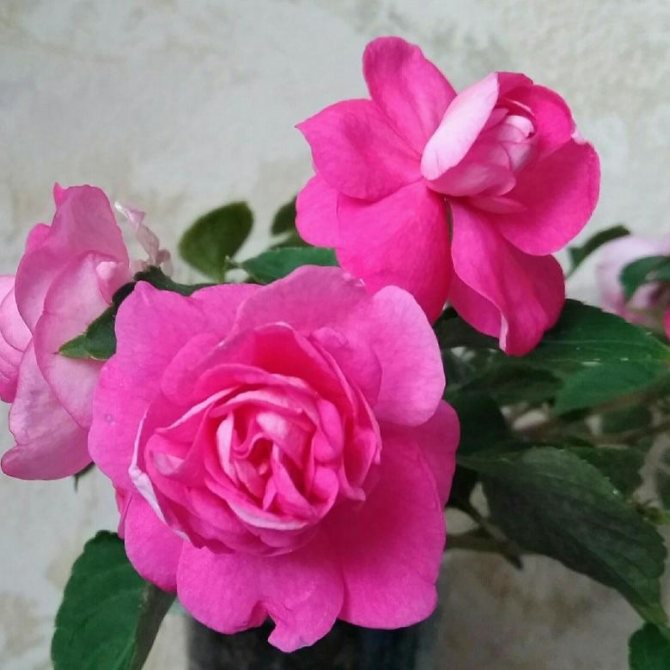

- Balsam super Elfin;
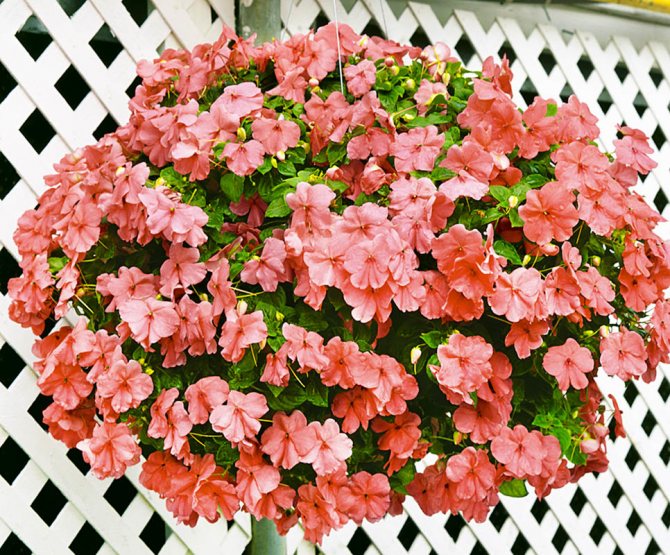

- Balsam New Guinea;
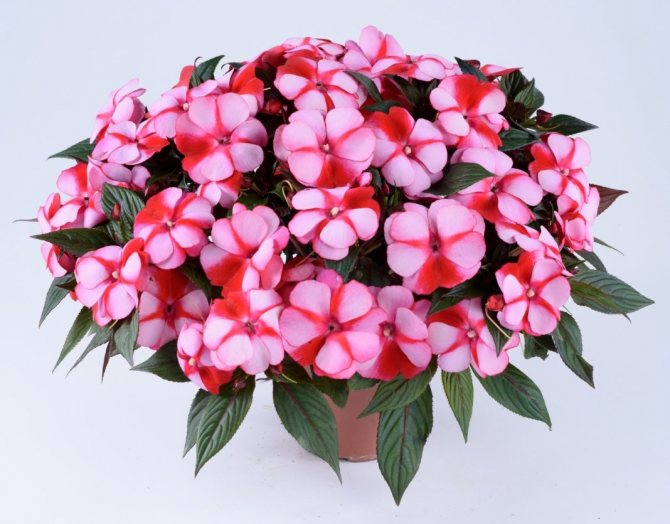

- New Zealand balsam;
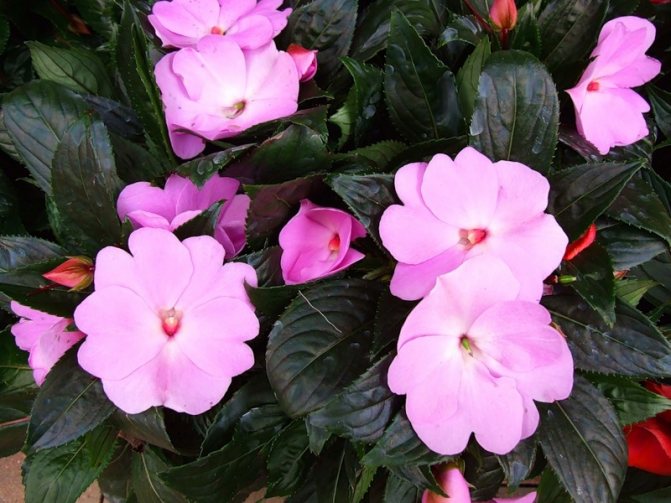

- Tom Tamb;
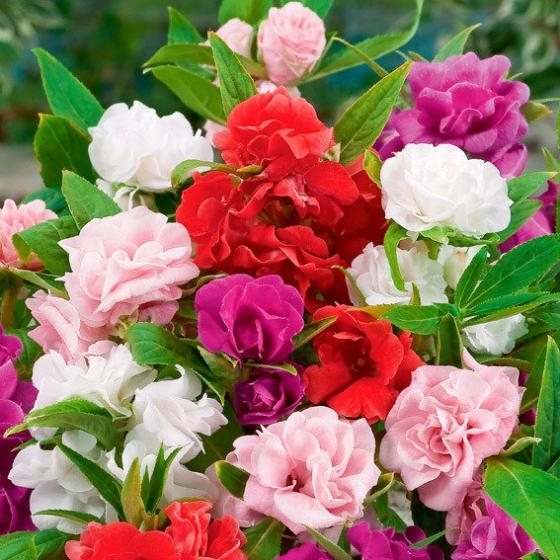

- Camellia;
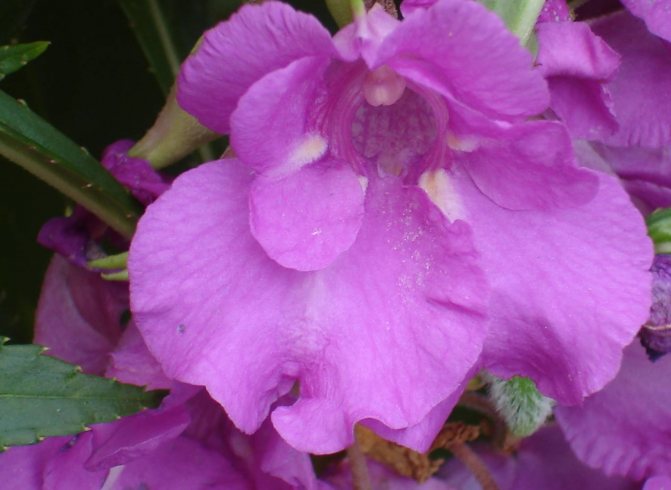

- Waller;
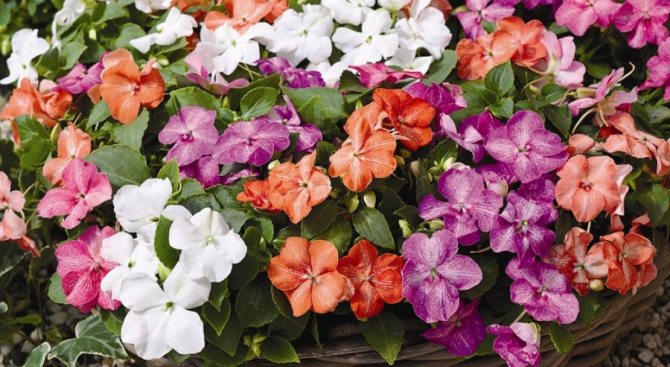

- Kandy;
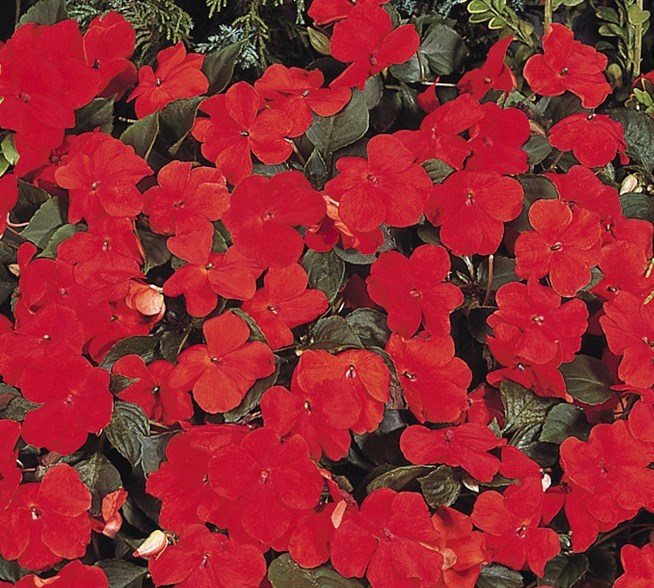

- Exotic;
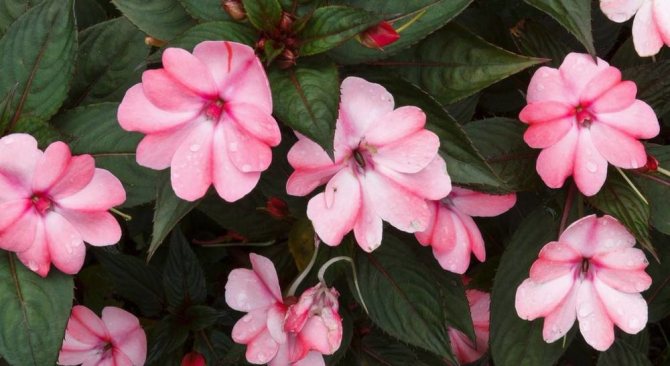

- Eurasia;
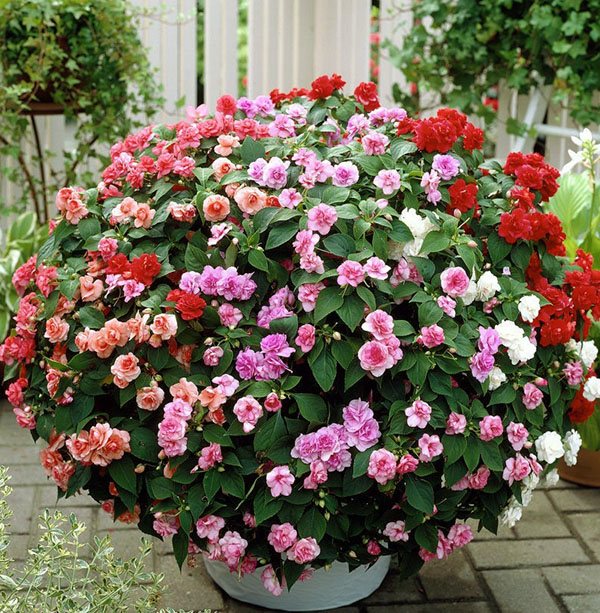

- Viennese waltz;


- Acrobat;
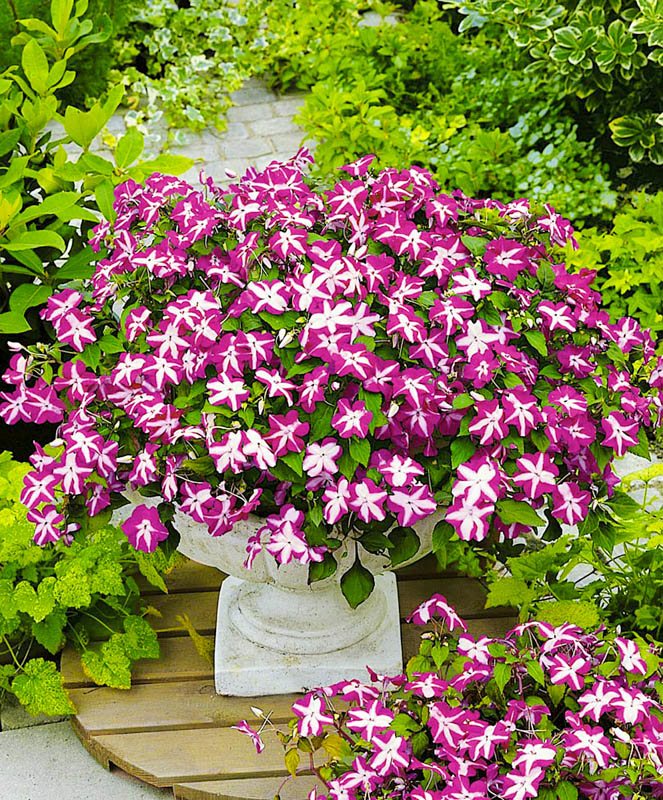

- Lollipop.
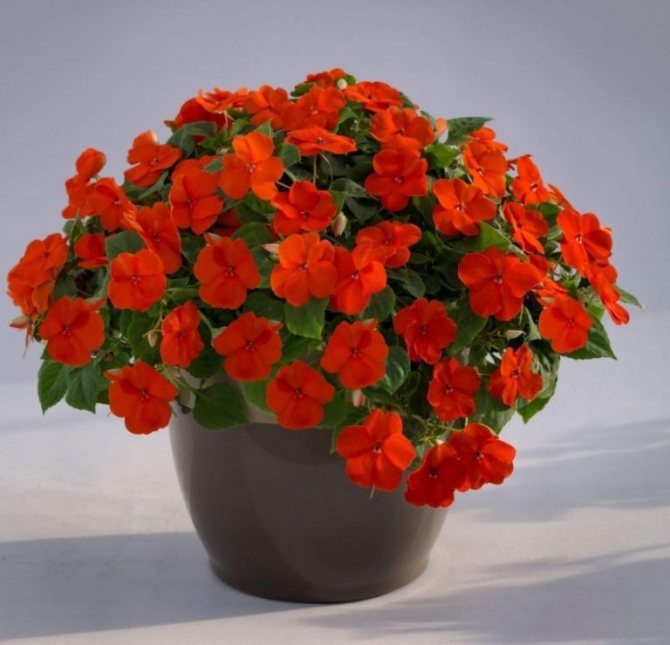

Balsam Care Tips
For the excellent development of his balsam, the florist must provide it with moisture and partial shade lighting. The flower itself loves the sun, but just the same record growth readings appear with dim lighting, but you should not transfer the balsam into the shade completely, this can lead to the death of the plant.
Temperatures vary at different times of the year. In summer and spring, the optimal temperature will be 25 degrees Celsius, this temperature should be simultaneously with good moisture of the substrate and the obligatory presence of fresh air. Indoor balsam prefers a temperature of 22 degrees Celsius with moderate humidity.
In the summertime, this herbaceous plant can be taken out into the open ground. If the flower remains at home, it must be watered quite abundantly. Watering itself is done along the edge of the pot to avoid moisture getting into the root collar. After watering, excess water is poured out of the sump. The water should be soft, because when using hard water, there is a white coating on the surface of the soil, which serves as an indicator of an excess amount of alkali in the soil. If it appears, the top layer of the earth is replaced.
IMPORTANT! Rare watering can lead to a lag in the growth of balsam, which leads to the fall of the flowers.
From time to time it is required to loosen the soil, but not more than two centimeters deep, and also do not forget to feed with fertilizers in summer and spring. The frequency of fertilization is once every two weeks.Also, balsam does not have a pronounced "quiet time", so the buds can appear even in winter, so it is necessary to make a weak feeding.
Lighting and location
This plant is not demanding for light. It is better to choose a place away from the sun. In winter, you should create the missing lighting for it. Lack of light will have a detrimental effect on the plant. The shape of the bush will change, shoots can be extended. In optimal light, the balsam forms a compact shrub with vibrant flowers.
Ground requirements
New Guinea Balsam loves loose soil that allows air to pass through. To prevent water from stagnating at the bottom of the pot, drainage should be done. The soil can be purchased in stores, as well as made by yourself.
New Guinea Balsam is an innovative hybrid that stands out for its larger inflorescences and a powerful stem.
Differs in a huge variety of varieties of different colors from monochromatic to multi-colored.
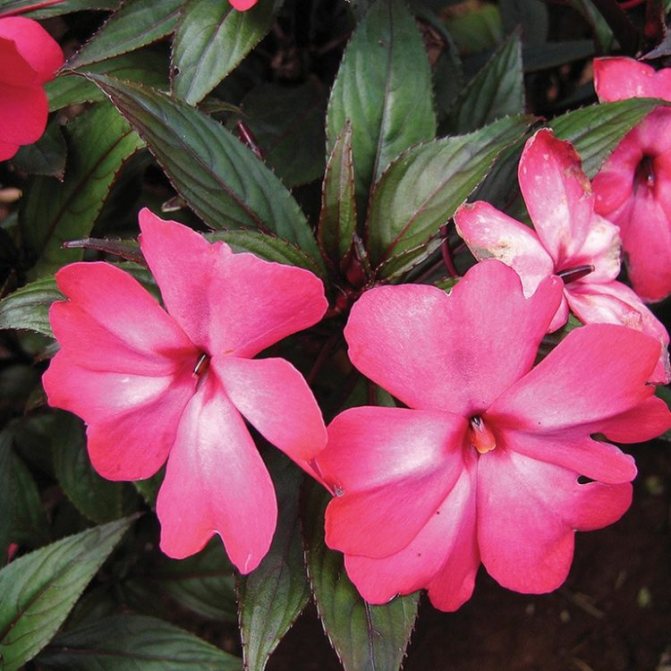

Flowering takes a very long period, the species can delight with bright inflorescences all year round, without interruption.
New Guinea balsam is considered to be an unpretentious and hardy plant, but, being in adverse conditions, it can quickly lose its attractiveness and decorative effect. In order for the flower to please for a long time with a beautiful and lush flowering, it is recommended to adhere to some very simple requirements when growing.
The flower needs good lighting, but without direct sunlight. The ideal location is east or west window sills.
In winter, when the plant needs 14 hours of daylight hours, it must be artificially illuminated using phyto-lamps. With insufficient lighting, the shoots will stretch out, the bush will become loose and outwardly not so decorative.
This plant is thermophilic, it needs an optimal temperature of 18-24C all year round. Many varieties do not tolerate sudden temperature fluctuations, so they are exhibited outside when the difference between day and night does not exceed 5C. In addition, in winter, balsams must be protected from cold drafts, even with short-term exposure to frosty air, its leaves can freeze slightly.
Balsam New Guinea loves nutritious, light, loose and moisture-absorbing soil. For growing, a ready-made universal substrate for home plants is suitable, to which experienced flower growers recommend adding expanded clay or vermiculite. Drainage is required, it will protect the flower from the destructive stagnation of water.
Watering balsam should be regularly and abundantly, but in no case should water stagnate in a flower pot, from its excess, thick and juicy stems can rot. When growing, it is advisable to adhere to a regime in which the soil will constantly be in a slightly moist state. The ideal air humidity around the plant should be in the range of 50-60%.
Too dry air contributes to the dropping of buds and flowers. In winter, in the morning and in the evening, the leaves of the plant should be sprayed with purified boiled water, if possible, without getting on the flowers. You can also increase the humidity if the flower pot is placed on a pallet with damp pebbles or expanded clay.
Twice a month, the plant needs to be fed with a weakly concentrated solution of fertilizers, in which potassium prevails. Nitrogenous fertilizers are best avoided, as nitrogen promotes accelerated green growth at the expense of lush flowering.
Home care for the plant is simple. The prepared earth for planting the light is loosened by adding humus and fertilizers. Depending on the size, the plants are planted at different distances from one another.
To make the bushes beautiful, long shoots are cut to half the height before flowering and the branches are pinched until flowering. You can grow a light on any window, no matter where it goes. The flower will rati equally well.
Transfer
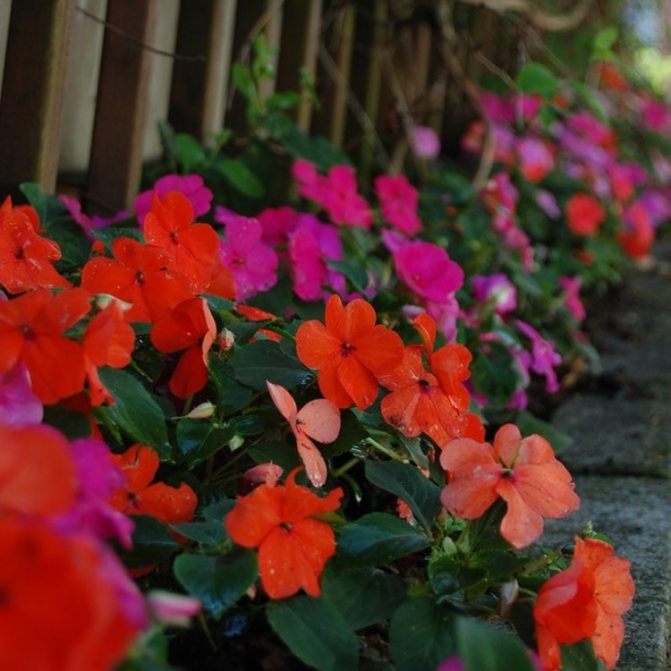

If a touch-me-not needs a transplant, they usually do it in mid-spring - early summer. But flower growers need to remember that the light blooms most magnificently in a cramped pot. During transplantation, old branches are also pruned on the plant to give an impetus to the development of young ones. Young plants are transplanted annually, and you can not transplant, but reload.
Lighting
The light is photophilous and blooms well only when it grows in an open place. When grown in partial shade, it blooms much less than in the sun. But at the same time, open sunlight depress the light. Therefore, it needs to be slightly shaded. A herbaceous shrub can also grow on the balcony on the north side. A few hours of bright color is enough for him, at least with a special lamp, and he will bloom vigorously.
Soil composition
The light feels comfortable on slightly acidic soil, light and permeable. Therefore, in the place of planting of balsams, the best soil mixture will be, consisting of garden soil and sand in a ratio of 3: 1. If the soil in the garden is heavy, with a lot of organic matter, it is better to prepare a mixture made up of two parts of the earth, the same amount of sand and one part of peat. The top layer of soil must be removed, drainage is laid and then the prepared mixture is poured. You can also add about as much humus as the peat was added.
Forming significant biomass in a short time, balsams need abundant watering. But with increased amounts of water, tender roots and the lower part of the stems at the root collar are quickly affected by rot, and the plant may die. Therefore, plants on dense soils need good drainage. Stagnant water is unacceptable.
Air humidity
For any varieties and types of plants, this parameter is not important. But if the temperature of the environment of its growth becomes higher than 22 ° C, the bush will have to be moistened by spraying, because the drying out light, losing a lot of moisture from the surface of the leaves, will begin to lose all the moisture that is in it and can dry out, despite watering the soil.
Top dressing
Since balsam blooms profusely all season, or even a year, it needs to be fed. They do this every one and a half weeks, alternating organic fertilizers with mineral flower additives. But it should be remembered that you should not overfeed the plants. This leads to the fact that they begin to "fatten" and bloom less.
However, you should not overfeed the flower with nitrogen fertilizers. This can cause active growth of stems and foliage, and in this case the grower will not wait for flowers.
Miniature varieties and hybrids with a variety of colors, obtained by breeders as a result of painstaking and long work, are excellent for growing in an apartment environment. However, in order to contemplate profuse flowering over an extended period, it is necessary to provide proper care for the balsam.
Ground requirements
Balsam feels good on fertile light soils, therefore, for cultivation, a substrate for decorative flowers is purchased in specialized stores or it is prepared independently from leafy earth, turf, peat and sand in equal quantities.
Important! When using self-prepared potting mix, it must be decontaminated before filling the pot.
In this article, we will take a closer look at home care for New Guinea balsam. Rest assured, it does not require any special skills.
Temperature
Balsam Novogvineysky is very fond of heat, easily tolerates heat. The ideal mode is a constant temperature within 22-26 ° C without sudden changes and drafts. At temperatures below 12 °, the balsam will die.
Even a short exposure to cold leads to freezing of the leaves.
It is recommended to take out a delicate plant to the street or balcony during the day in the absence of wind; it can be left at night only when the difference between day and night temperatures is no more than 5 °.
Lighting
The New Guinea hybrid loves light as much as warmth. Which does not prevent him from suffering from direct exposure to the sun.
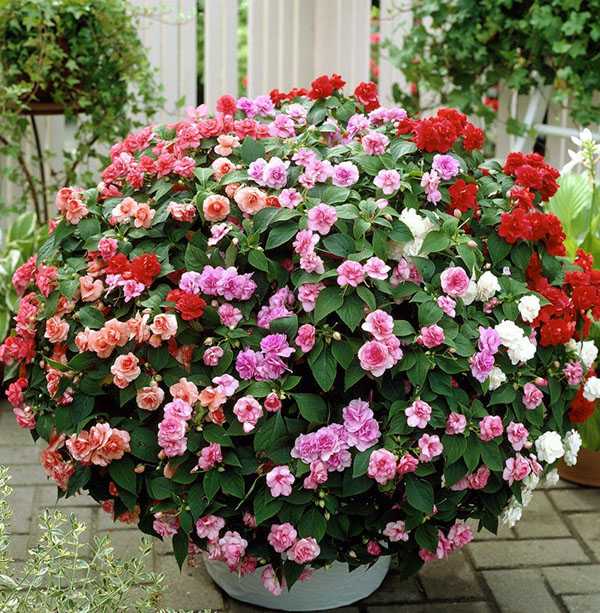

In order not to harm the plant, it is placed on the windowsill of the western or eastern window.
In winter, additional lighting is provided so that the balsam receives a 14-15 hour light period.
Lack of light will lead to loosening of the bush, loss of compact form, shoots will begin to fade and ugly stretch towards the light source.
New Guinea balsam needs a lot of moisture, the principle "It is better to pour than to underfill" applies to it. Even short-term dryness causes detrimental effects and stress on the plant, to which it reacts with wilting of leaves and a decrease in overall turgor. Recovery is proceeding very slowly.
Sowing seeds: steps and important tips
Seed material of balsam does not need stratification, but it must first be disinfected. Potassium permanganate (potassium permanganate) is diluted in heated water so that it turns light purple, and then the seeds are lowered there and kept for 10 minutes. After that, the liquid is drained, and the seeds are soaked in warm purified water and kept there for another day.
Balsam is picky about soils and prefers light substrates with low acidity. The soil can be either purchased or self-prepared at home from the following ingredients:
- 2 parts of peat;
- 1 part of vermiculite, garden soil and coarse sand.
If it is not possible to use garden soil, it is allowed to use vermiculite and peat in an equivalent ratio. The prepared soil is calcined in the oven for about two hours to eliminate all harmful microorganisms, and then spilled with Fitosporin diluted in water. This allows you to optimize the microflora of the soil and reduce the risk of plant damage by the black leg.
A wide, low pot or box 7-8 cm in height is used as a container for seedlings. The bottom is covered with crushed gravel or expanded clay with a layer of 2 cm for drainage.
Seed material swollen from moisture is evenly distributed over the surface of the soil, trying not to pour them too often. Since the seeds are small, it is preferable to do this with the tip of a wooden toothpick. They must be carefully pressed to the ground, not burying too deeply.
The surface with seeds spread out on it must be sprayed with a spray bottle. Then the container is placed inside a transparent plastic bag. It should not be pressed too hard so that there is enough air for the seedlings.
Transfer
Balsam New Guinea grows rapidly and after 2-3 years it loses its compact form. If the plant is young, then it can be transplanted, but it is better to update the older flower by cuttings. Balsam does not have a dormant period, so it can be transplanted at any time of the year.
Balsam grows and develops rapidly, blooms for a long time, therefore it needs regular soil renewal and replenishment of nutrients. Transplanting is carried out every year outside the flowering period. Step-by-step instructions for transplanting.
- Thoroughly spill the soil in the balsam pot a few hours before the procedure.
- Get a new pot slightly larger in diameter than the old one.
- Treat it with a solution of potassium permanganate of medium concentration for disinfection.
- Prepare new soil.
It should be moisture-absorbing, breathable, loose and nutritious enough. You can mix humus, leafy soil, sod soil, peat, to loosen and retain moisture, add crushed expanded clay and vermiculite.From the finished one, a nutritious soil for flowering plants is suitable.
- Remove the plant from the container, gently shake off the old soil, exposing the root system. It can be rinsed with warm water if necessary.
- Perform a visual inspection of the roots, remove all suspicious, dead and aged ones. Cut off decaying areas with a very sharp tool to healthy tissues. Disinfect the wounds with crushed coal or ash.
- In a new container, place a drainage of stones at the bottom, pour earth on top and place a bush.
The roots should be spread out and loose. - Close the root system with soil, pouring it up to the root collar, tamp it.
- Spill the soil with a weak solution of potassium permanganate from a watering can, so as not to wash it out.
Hybrid varieties such as New Guinea Balsam do not require regular pruning. To enhance branching, at the request of the owner, you can pinch the young tops.
Pruning is necessary if the plant has experienced stress, was in a place with low light, or received excess moisture for a long time. At the same time, its branches stretched out, and the whole bush lost its decorative effect. Such stems are shortened and used for vegetative propagation. When pruning, care must be taken to leave lateral buds for branch growth.
Balsam transplant:
- The transplanting process is carried out for plants that are grown indoors.
- Balsam grows and develops rapidly, so it is necessary to change the soil every year.
- The transplant is carried out during the dormant period, when all the flowers have fallen off.
- Before you get the rhizomes, you need to water the soil well.
- A pot is pre-prepared, the diameter of which is slightly larger than the old one.
- The soil is selected loose, breathable and fertile. You can buy it from a specialty store or make it yourself. To do this, the sod land is mixed with leafy soil and humus, peat and expanded clay are added.
- The flower is carefully removed together with the earthen clod from the old pot, and the root system is cleared of soil.
- Each part is scanned for disease, rot and dry areas, which are removed with a sharp knife.
- Drainage and some prepared soil are poured into the bottom of the new pot.
- Next, you need to place the root system, placing each branch around the perimeter of the bottom of the container.
- The substrate is poured up to the level of the root collar and compacted.
- The first watering is carried out with a weak manganese solution for additional disinfection.
Varieties
Ampelous terry balsam has many shaggy flowers. The chic shape of this variety is used for hanging baskets. It is a very branching plant, covered with flowers with shoots of 30–35 cm. It blooms from June until frost. The plant is grown in places with diffused sunlight or in partial shade.
Balsam ampelny Acrobat is distinguished by its rapid growth. One flower is enough to create a luxurious hanging basket. He has a huge number of constantly updated colors. It tolerates rainy weather very well. Balsam is best grown in partial shade. Blooms from June to November.
Video: New Guinea Balsam. Growing tips
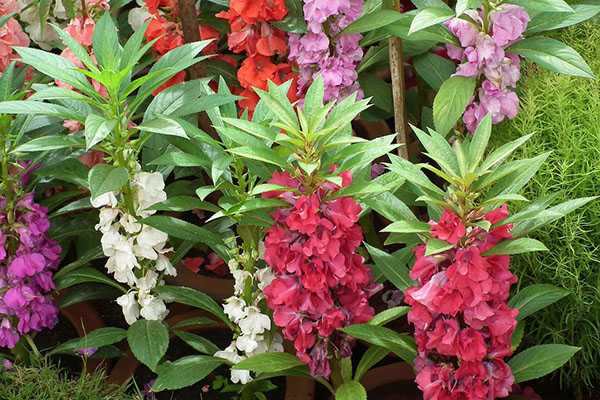

The flowerpot should be slightly cramped to ensure abundant and beautiful flowering. To increase branching, pinch the tops of the shoots. Pruning is not recommended, because after it thick and ugly stumps remain.
Top dressing
Young sprouts require slightly different care than an adult balsam.
The temperature during the day should be in the range of 21-23 °, at night a decrease to 17-18 ° is permissible.
Lighting is required bright, but diffused. Daylight hours - at least 12-13 hours.
Water in moderation, maintaining longer periods (over 2-3 days). It is worth waiting for the drying of the surface layer of the soil.
The air humidity is maintained the same as in adult plants.
Top dressing begins 8-12 days after rooting, reducing the concentration by 50% from the indicated one. The introduction of nitrogen at this time is encouraged, in addition, the seedlings need potassium fertilizers.
When to plant
In order to get flowering plants, it is necessary to choose the date of planting correctly.
General landing dates
In the Moscow region and other parts of the European territory of Russia, it is allowed to plant seeds already from the first decade of March. In the southern regions, you can postpone this date to February. In the rest of the country, this is not recommended as the growing season of the crop does not last too long.
Lunar dates
In order to successfully sow balsam seeds, they also resort to the help of the lunar calendar. According to him, in 2019, favorable days for the procedure are:
- February 21-25;
- 12-17, 19-20 March;
- 6-8, 11-13, 15-17, 29-30 April;
- 8-17, 21-23, 26-28 May;
- 1-2, 5-6, 9-13, June 16-20.
It is not recommended to plant seeds on the following dates:
- 6, 7, 21 March;
- April 5, 19;
- May 5, 19;
- June 3, 4, 17.
Diseases and pests
Quite often the plant is affected by spider mites. To protect the plant from them, it is necessary to regularly spray and put on a stand with water and pebbles, or treat it with an insecticide. Plants can also infect whiteflies, a sign of this can be the raising of white flies from touch. Soapy water will help get rid of this problem.
With root rot, the affected parts are cut off. The cause of the disease in almost all cases is associated with poor quality care or its absence completely. With rot, a white bloom may appear on the shoots. The disease cannot be cured in any way, but you can stop it .. To do this, you need to cut off all the damaging parts and treat with fungicides.
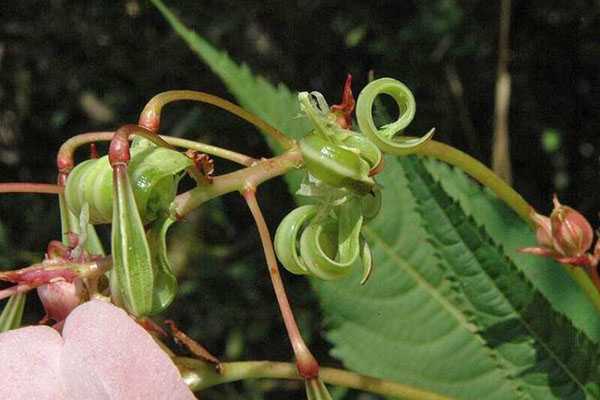

If the plants do not receive the normal amount of moisture, then the leaves will begin to wilt. To avoid this, you need to lower the balsam in a bucket of water for half an hour.
The main problems are:
- Leaves are falling. Occurs when there is no watering or low temperatures.
- The stems are extended. Occurs due to high temperatures or insufficient lighting.
- Insect pests. They are due to the lack of fresh air and insufficient humidity.
- The buds are falling. This is caused by a lack of light, high temperature, and a lack of water in the soil. Temperature drops are not allowed.
- Falling leaves or curling. Reduce humidity and provide warmth.
- Pale leaves. They happen most often in the winter season due to lack of light.
If the plant is properly cared for, pests will not damage the flame. In case of violations of the irrigation regime or feeding home care, perennials can quickly damage aphids, meadow bugs, whiteflies and strawberry mites. To destroy these uninvited "guests", plants must be treated with insecticides that are harmless to humans: These drugs are Bona Forte, Bitok-sibacillin, etc. When processing, you must follow the processing rules specified in the instructions.
Therefore, special attention should be paid to care, and if plants are damaged by any disease, immediately take action. For example, in cases of waterlogged soil in winter, the roots of plants are affected by gray rot. To get rid of this disease, it is necessary to reduce watering, and it is advisable to treat the soil with trichodermine or phytosporin, performing wet loosening.
In addition to rot, the mosaic virus or powdery mildew can settle on the light. To prevent this from happening, it is necessary to monitor the plant and carry out insecticide prevention. Bordeaux liquid is used as such a drug.
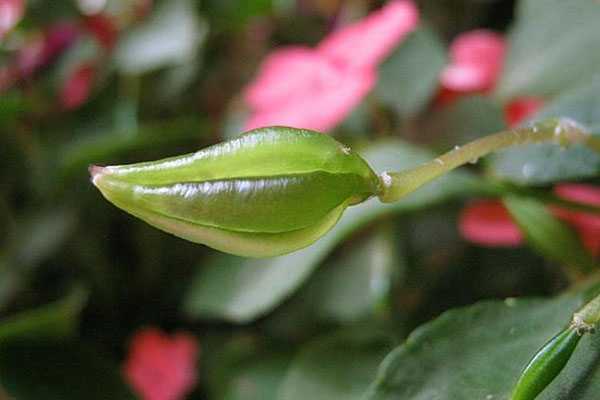

Spider mite attacks often occur with a lack of watering. A sign of the appearance of a tick is yellowing and curling of the leaves.In this case, the treatment will be the removal of infected leaves and treatment with chemicals, for example, "Aktellik", "Demitan", etc.
Perennial leaves fall or wither with insufficient watering. Sometimes hypothermia is the cause of this phenomenon. Sometimes balsam lovers are perplexed that their light does not bloom. Experts read that feeding is the reason here, or rather its excess or deficiency. Another reason may be a lack of lighting or an incorrect temperature regime.
Another problem that sometimes arises when growing balsam at home is crumbling flower buds. This is typical in case of waterlogging or drying out of the soil. This is often observed during the period of adaptation of perennials to new climatic conditions.
In rooms with temperatures below the permissible for a light, dark spots appear on the shoots. This disease is called bacteriosis. Treatment is carried out by transferring the plant to a warmer room and treating it with chemicals, for example, "Alirin".
The problems and ailments of New Guinea Balsam are a natural consequence of the wrong content.
- The appearance of light spots of different sizes on the surface of the leaves is the result of exposure to direct sunlight (burns) or spraying with hard water.
- Mass drying and falling of leaves and inflorescences occurs due to dry air or excessive soil moisture.
- The leaves turn pale, lose their color saturation with a deficiency of useful elements.
- The stems lose their turgor and droop, the leaves fall off in large quantities - excessive watering against the background of cool air (temperature below 18 °).
- Balsam does not bloom or produces very few buds - the lack of nutrition due to the poor composition of the soil or the lack of fertilizing affects.
Of the diseases, the most common are fungal rot - root, gray, stem base.
A common symptom will be softening of various plant tissues, the appearance of an ugly plaque on the surface, loss of normal turgor, wilting of leaves and stems.
It is impossible to cure such an attack, it can only be stopped.
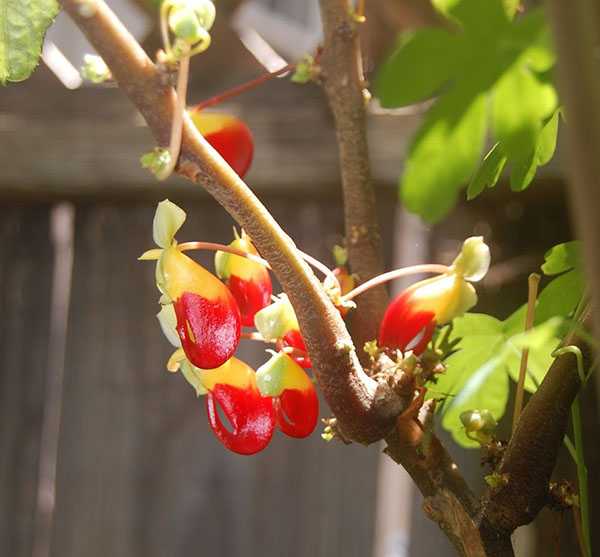

All affected parts and tissues are cut out without any mercy until only healthy cells remain. Sections are disinfected with wood ash, crushed activated carbon. Plants are treated with effective fungicidal preparations such as Fundazola, Acrobat, Oxychoma, Abiga-Peak, Maxim.
Pests also do not ignore the delicious balsam. Among his enemies, it is worth highlighting spider mites, which entangle the plant with a thin cobweb and suck out all the juices.
Whiteflies and aphids love their balsam no less. If the bushes suffer from an invasion of parasites, they should be removed in isolation and treated with insectoacaricides - Aktellik, Akarin, Fitoverm, Oberon.
Possible problems
In most cases, plant diseases are the consequences of improper care. The main ailments, problems and why they appear are described below.
- Wilted leaves. Most likely, the temperature is high and there is not enough moisture in the soil. Water the "touchy" more often, carefully ventilate the room.
- Leaves turn yellow, dry and fall off. Much moisture and low temperature. Place the pot in a warmer place and adjust the frequency of watering.
- Flowers and buds fall off. Or do not appear at all. Insufficient light, dry and hot air. Prevent sudden temperature fluctuations, do not overfeed. Place the flowerpot in a well-lit area.
- Leaves do not grow and turn pale. The size of the pot is not correct. The problem appears due to a lack of power and light. Transplant the "touchy" into a large container, providing good lighting and regular feeding.
- Leaves curl. The plant is cold and damp. Move it to a warm, drier place.
- Weak bloom. Improper feeding. Reduce the dosage of fertilizers that contain nitrogen.
- Light spots on the leaves.The plant was sunburned or sprayed with hard water. Place the pot out of direct sunlight, use only filtered water for irrigation.
"Touchy" often suffers from fungal rot - root, gray. Common manifestations of diseases are the appearance of plaque, softening and wilting of leaves and stems. Plant resuscitation: the affected areas are removed, the sections are treated with ash or activated carbon. Such fungicides as "Maxima", "Fundazol" are effective.
Reproduction and planting
Balsam has two main methods of reproduction, let's talk about them in more detail.
Cuttings
It is the most common way of balsam propagation. The whole complexity of this method lies in the strict observance of all conditions, thanks to which the plant will not only take root in the future, but also ensure good growth. This is actually the principle of this method.
REFERENCE! It is imperative to pay attention to the type and age of the maternal stem.
Cuttings are separated from the mother stem only after the cutting itself has taken root.
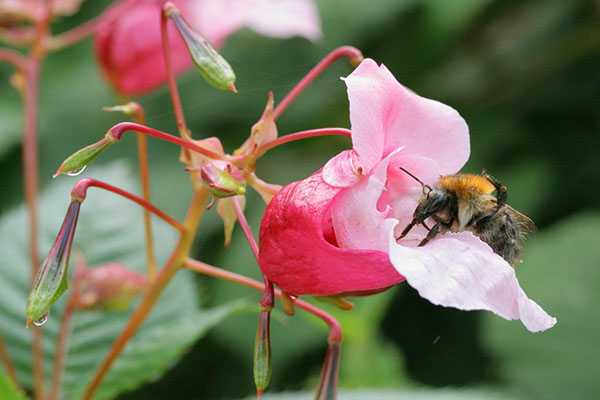

To stimulate the growth of cuttings, the mother's stem is cut. The growth of cuttings, as well as their quality, depends on the frequency of cutting the mother stem. The formation of the root system in cuttings is a direct sign of the readiness of this very cuttings.
The very ability of cuttings to take root can change throughout the year, that is, it is unstable. The cuttings process is best started in the middle of summer. During the time until autumn, it is necessary to store cuttings. Half-stiff cuttings should be left at the end of summer.
For the best quality cuttings, it is necessary to monitor the temperature and humidity. Temperature conditions strongly influence the root growth process. When rooting cuttings, the ideal temperature is considered to be 21 degrees Celsius, but the air temperature should be lower.
Seeds
For the highest quality and fastest growth, it is worth planting seeds in peat tablets, placing one in each hole. The seed itself should be placed on the surface, since the balsam is very fond of sunlight.
After germination, everything should be transplanted into a plastic container with holes. the box in this case plays the role of a greenhouse. Further, the transplant should be carried out after the appearance of 2-3 leaves, the transplant must be carried out in a loose, well-moistened soil. After the final emergence of all seedlings, it is necessary to maintain a high humidity.
REFERENCE! If the plants emerge too densely, they should be separated. Watering the plant in the future should be very careful so as not to damage it.
This species is a picky and resistant plant, but with improper care, it can begin to wilt quickly or even completely die, losing its beauty. To prevent this from happening, a number of simple care rules should be followed. Then the balsam will delight the eye for a long time.
Growing balsam from seeds
In order to properly carry out the cultivation of balsam from seeds, you need to use a wide container with a sufficient number of drainage holes. If there are seeding cassettes available, then one seed is planted in them. Young plants dive after the appearance of several leaves. For planting seeds, loose, light soil is used, in which there is no organic matter. The seeds are laid out on the surface of the soil and tamped a little, after which they are sprayed from a spray bottle. Regarding the timing, growing balsam from seeds: when to plant, it is usually in February-March, given the type of plant.
Preventive actions
With improper maintenance and care, a flower can not only be subject to diseases, but also acquire an unattractive appearance. To prevent this, flower growers recommend taking preventive measures.
The most effective way of prevention is considered to be careful plant care. You need to monitor the moisture content of the soil, lighting, and also systematically carry out top dressing, the absence of which leads to the scarcity of flowering.
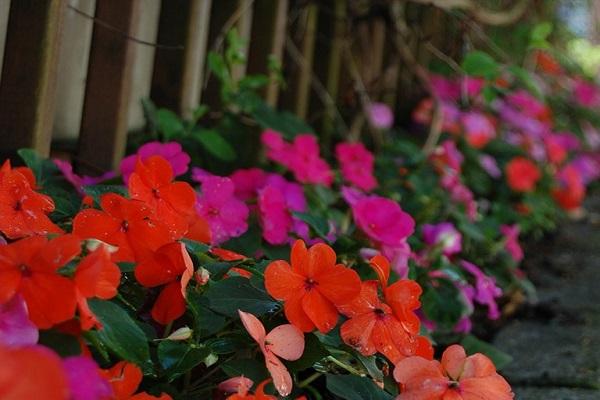

Basic room types
A fairly large number of varieties have been bred. Each of them has its own characteristic height, color of leaves, shape of buds. Depending on the parameters, the following three groups are distinguished.
- Compact undersized bushes up to 20 cm high. They have small flowers. Perfect for growing in pots on windowsills, in greenhouses.
- Spreading flowers of medium size. They are shaped like a pyramid. Looks very nice in hanging pots.
- Vigorous bushes up to 50 cm high. They are distinguished by erect shoots. In the interior, they are combined with other cultures, as they look poorly alone. They are especially good in massive flowerpots.
There are several series that are recommended for home floriculture. They are described in the table.
Table - Indoor types of New Guinea balsam
You can also give preference to the Java variety, which boasts a wide palette of flower shades. Alternatively, you can pay attention to the Mini Jini with abundant flowering.
Soil requirements
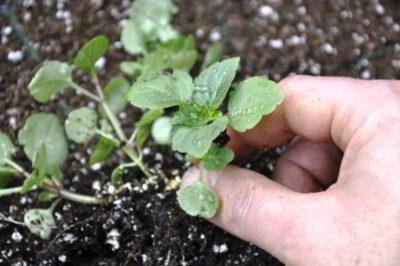

For planting ampelous balsam, it is necessary to prepare a loose, slightly acidic substrate... You can prepare it if you take the following components in equal amounts:
- peat;
- vermiculite;
- leafy ground;
- river sand.
You can buy ready-made potting soil at the store. Put some sand in the pot before using it. It is necessary to quickly remove excess moisture from the soil. If this is not done, then the root system of young plants will rot.
Reproduction of indoor balsam
Like many plants, Variegated New Guinea Balsam can be propagated in several ways. Consider how to root a flower in water and how it reproduces with its own seeds.
Seeing this gorgeous plant on the windowsill, most lovers of indoor flowers immediately wonder how to propagate balsam. The best way to propagate is by cuttings. To do this, you need to take the top of the shoot, on which there are at least three internodes, and, after cutting it slightly below the latter, root it in water or in well-moistened sand. Within two to three weeks, roots are formed on the young cuttings.
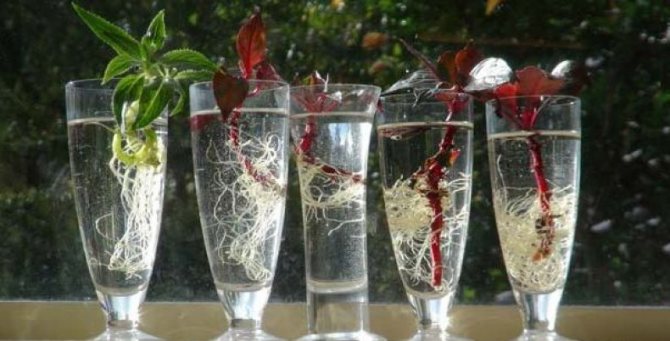

You can also try to grow a flower from seeds that form after the flowers fall. To do this, you need to collect well-ripened seeds, dry them in a well-ventilated place and sow in pots with a peat-sand mixture (50:50). Drizzle with warm water and cover with plastic wrap.
Read also: Geranium: description, medicinal properties, use in traditional medicine
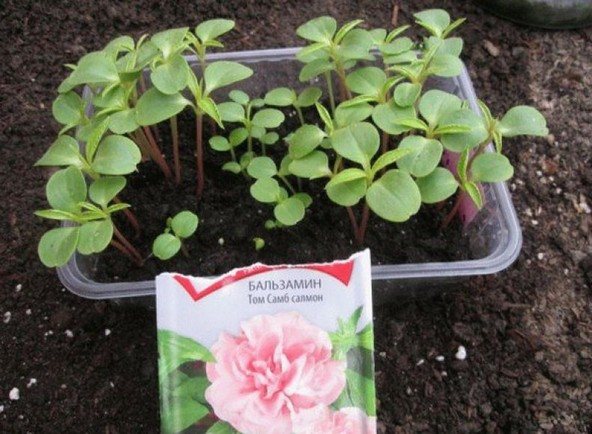

Features of care in summer and winter
Winter and summer care consists of the following steps:
- In the summer, as often as possible to water, and in winter, watering should be reduced.
- Temperature should be no more than 25 degrees in summer, and should not drop below 10 degrees in winter, otherwise the leaves will simply wither.
- In winter, the flower needs additional lighting.
- Should reduce feeding balsam in winter.
- Transplant and reproduction best produced in spring or summer. This is not allowed in winter.
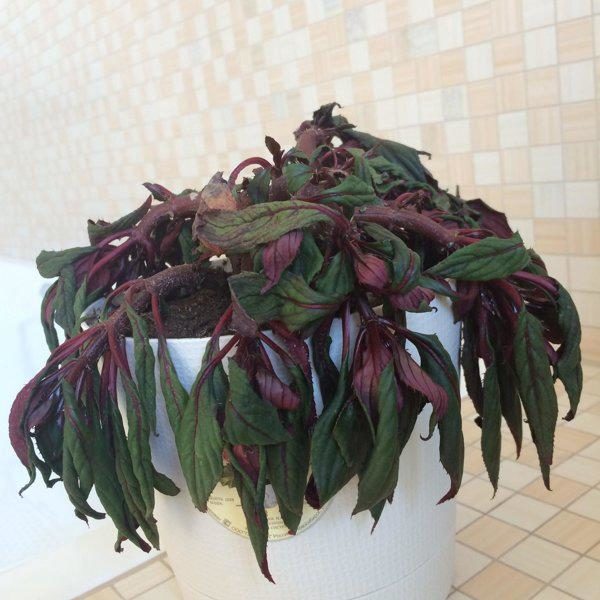

The air temperature in the room should not fall below 10 degrees, otherwise the New Guinea balsam will simply die
In winter, New Guinea balsam calmly tolerates all conditions, if provided:
- moderate watering;
- additional lighting;
- optimal humidity air;
- suitable temperature;
- draft protection and cold.
Interesting Facts
There is an opinion that the color of balsam buds with its energy flows can influence a person:
- orange - awakens sexuality;
- red - increases physical activity;
- purple - stimulates mental abilities;
- white - generates spirituality;
- pink - evokes emotionality.
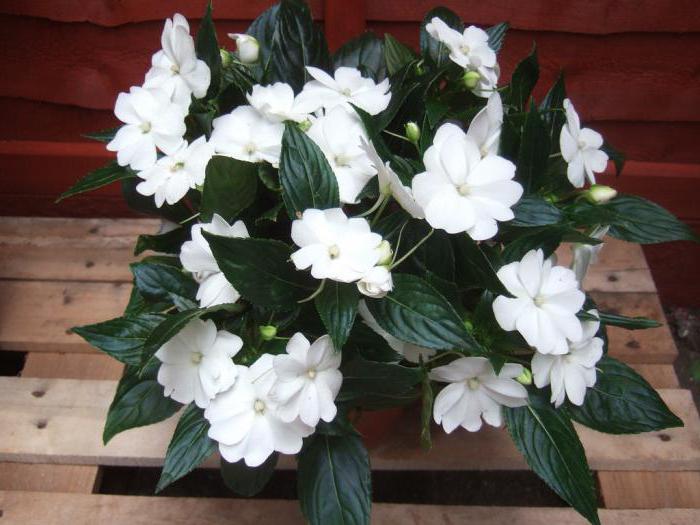

Beneficial features
A decoction of fresh balsam leaves is used as an adjuvant for stones in the bladder, kidneys. The decoction added to the bath will relieve pain in rheumatological diseases. For the treatment of wounds, ulcers and hemorrhoids, applications are made from leaves. Tincture on roots, flowers and seeds helps with fatigue, relieves headaches.
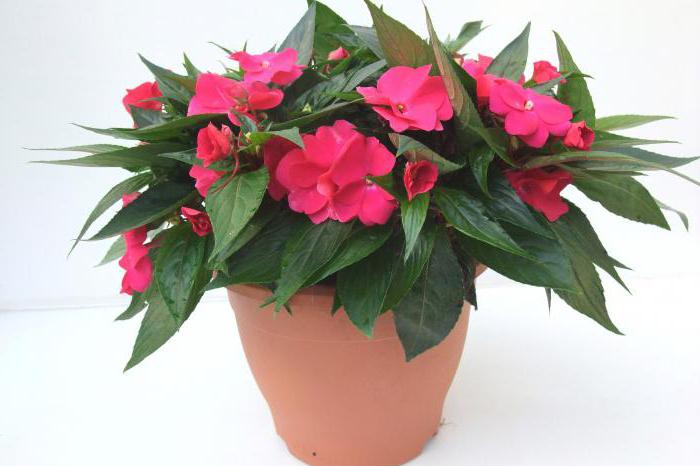

However, it must be remembered that balsam is toxic and its chemical composition is not well understood, for this reason, therapy should be carried out very carefully. In case of an overdose, the following symptoms appear:
- dizziness;
- vomiting.
Fertilization and feeding
To feed the flower, complex fertilizers with a high potassium content are used.
The balsam fertilizer mixture should not contain nitrogen, because it leads to a sharp decrease in flowering due to an increase in foliage.
The plant is fed 2 times a month. At the onset of a period of intense flowering, fertilizing is reduced to 1 time.
Growth rate
Balsam "New Guinea" grows fast enough. It is necessary to ensure that the plant develops not so much in height as in width. When pinching the shoots, the balsam grows thickly and becomes decorative.
Life span
The duration of active growth and flowering lasts up to 3 years in indoor conditions, then the plant must be cut and planted again.
When grown outdoors, balsam turns into an annual plant.
Smell
Balsam flowers do not have a specific smell.
New Guinea hybrids and a simple reason for their rise in popularity
Among all varieties, groups of varieties and even species of balsams (Impatiens), the so-called hybrid varieties of the Nuova Guinea group or New Guinea hybrids (often labeled as New Guinea Impatiens) are today considered the best, although some time ago these plants were considered one of the most capricious and extremely "Western".
The change in status and the rise in popularity of the touchy New Guinean is simply explained: these plants boast a unique ability to bloom all year round. And although in regions with harsh winters they are grown only as seasonal plants in the garden, they cannot be found equal in room culture. The unique flowering time can be appreciated even in the middle lane.
The two main traits of New Guinea hybrids are meatiness and power. They have strong shoots, very densely spaced bright dark green leaves and pretty bright asymmetrical flowers, as if evenly scattered throughout the bush. The beauty of both greenery and flowering distinguishes them from more than half a thousand species and many thousands of varieties of balsams. And it seems inappropriate to add folk nicknames to this plant - a light, Vanka is wet, touchy. Although the main feature of balsams is the scattering of seeds, the cracking of the capsule at the slightest touch is also preserved by the New Guineans.
New Guinea hybrids first appeared on the flower market in 1972, and the group of these hybrids can be called relatively young. It is believed that they were bred by crossing the Indonesian touch-me-not Hawker with other species. These plants up to 20-30 cm in height can be considered both indoor and garden varieties, but they fully show their talents in the premises. In fact, these are versatile varieties that you can use as you see fit. They have very compact, dense bushes and much stronger shoots that are more resistant to injury than ordinary balsams.
Leaves are dense, broadly lanceolate, sit on short petioles in whorls, decorated with a finely serrated edge, in some varieties they can reach 10 cm in length. On the leaf blades, “sunken” veins are clearly visible.And the flowers are much fleshy, larger, up to 5-8 cm in diameter, with graceful petals and a small colored eye. Flowers bloom in axillary "bunches" or one at a time. In horticultural culture, New Guinea balsams bloom only in spring, but when grown in room culture - all year round.
The colors of the New Guinea hybrids are also appreciated - pure pastel or watercolor shades of color and rare variations of pink shades, fuchsia, candy, salmon, peach, apricot tones. The color of the leaves is also very variable: in addition to an intense dark green, different varieties have brighter variations, and original shades - bronze or with a yellowish enlightenment in the center of the leaf blades.
The variety of New Guinea hybrids allows you to choose both more compact and large plants, which are very different from the more familiar Waller's balsam. Actually, according to their size, they are divided into three groups - compact (up to 20 cm), sprawling ampelous and high (up to 60-90 cm) varieties.
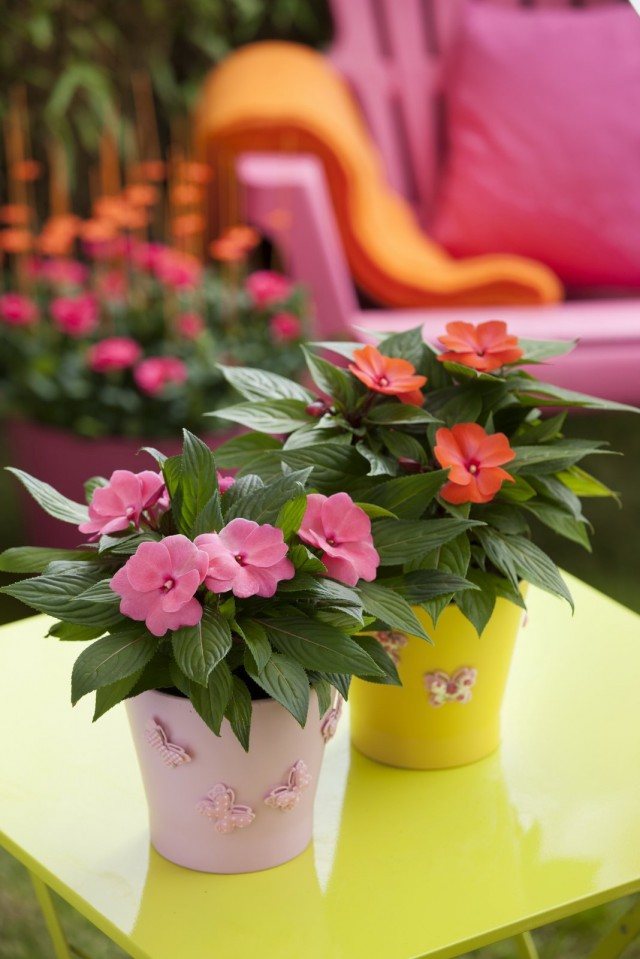

New Guinea balsams. <>
In New Guinea hybrids, not separate varieties are most often distinguished, but whole series of varieties. The best of them are:
In growing New Guinea balsam hybrids, the most important thing is to choose the right conditions for keeping and choose the plant itself with all attention to the "details". On sale New Guineans can be found mainly in the spring. But many floral balsams are delivered by fall. When buying, the bushes should be carefully examined, noting the slightest signs of disease or pest damage: if you miss even a speck, then the plant will not be cured and, most likely, you will just have to throw it away.
Testimonials
- Katerina, 26 years old: “I fell in love with balsam in one of the flower shops, but the price for an adult plant at that time was high for me, and I decided to grow it myself. I bought seeds from the same store, they are safely hidden in a paper bag, which contains a capsule, there were several small seeds in it, they are so airy, I was afraid that in any draft they would fly off the pot, because it is not recommended to drop them in when planting. After the first watering of the earth from the spray bottle, the seeds themselves pressed into the ground. The first shoots appeared in about three weeks, I already began to worry that they did not start at all. After they have grown and decorated with wide leaves, I transplanted them into peat cups. Some had to be planted in twos, because I could not separate their roots. As a result, I had three hanging planters on my balcony with densely dangling branches, densely covered with flowers. " But what reviews of Balzamin Camellia exist, you can find out by reading this article.
- Olga, 54 years old: “In a garden store I liked a bag with seeds of ATENA EPLBLOSSOM F1 terry ampelous balsam. There were only 8 seeds in it. Since I never germinated seedlings for flowers from seeds, I approached this process with all seriousness.I prepared a special mixture, poured it into a shallow container, arranged the seeds in two rows at a decent distance from each other. Sprayed the ground periodically. And when the entrances appeared, I carefully watched that three leaves appeared on them, then transplanted them into small disposable plastic cups. Out of eight seeds, I took five. As soon as the seedlings got stronger, I immediately planted them in hanging pots and hung them on the balcony, I have it glazed, so it has been decorated with balsam since May. "
Lighting and location
Attention! The flower is unpretentious to lighting. It can grow quietly even in the corner of the room. But it is possible to achieve abundant and constant flowering only if there is bright light.
You should not keep a flower on the south window at the height of summer or you need to create protection for him from the scorching rays of the sun. The east and west windows are perfect. In summer, take out the balsam to the balcony.
The flowering plant will be a great decoration for the garden, but it should not be planted in the sun. Light partial shade will do.
How to care?
When three leaves appear on the seedlings, you will need to pick the seedlings. They can be transplanted into peat or plastic cups. Balsam is very hygrophilous, but it should not be poured, its roots will suffer from this. If the seedlings have grown elongated, then they should simply be placed deeper into the ground when diving. After it, the plant still needs greenhouse conditions, so you should not immediately remove the film from the pots, it is necessary to gradually tame the seedlings, sometimes opening the glass or film for a while.
Young shoots of balsam soon begin to create mini bushes, if this does not happen, then you need to pinch the tops with them, the more side shoots go out of it, the more bushy the plant will be.
After picking, the seedlings must be regularly sprayed, especially in hot weather. Once the plant has strong roots, it can be planted outdoors or in pots. The right time for this is mid-June.
The video shows how to grow from seeds:
Diseases and pests
In winter, the plant is susceptible to fungal diseases, especially gray rot attacks it. Eliminate it by the following method: clean the roots of the plant from the old soil, transplant it into new soil and a pot.
When there is little moisture in the room where the balsam grows, then it is annoyed by the spider mite. The first sign of its settlement on the plant is the twisted leaves, which begin to fall off by themselves. Preparations in the form of Karate, Dimitam and Aktellik will help to cope with the tick.
The presence of white carp balsam on the bushes is indicated by yellowing leaves. It usually settles on the inside of the lower leaves. You can get rid of it by using special means: Decis, Fufanon and others.
It is not easy to grow ampelous balsam from seeds, but if you follow all the recommendations, you can end up with healthy and long-flowering bushes. They will decorate any garden, house and balcony. The decorative effect of the plant is established even during the growth of seedlings, in order to enhance it, it is worth periodically sprinkling the plant with "Zircon" or "Kornevin".
Balsams in the wild
In nature, there are many different species, for example, there are shrubs, herbaceous annuals and perennials. Some species grow up to two meters in height. All of them, without exception, are combined into one family - balsamic.
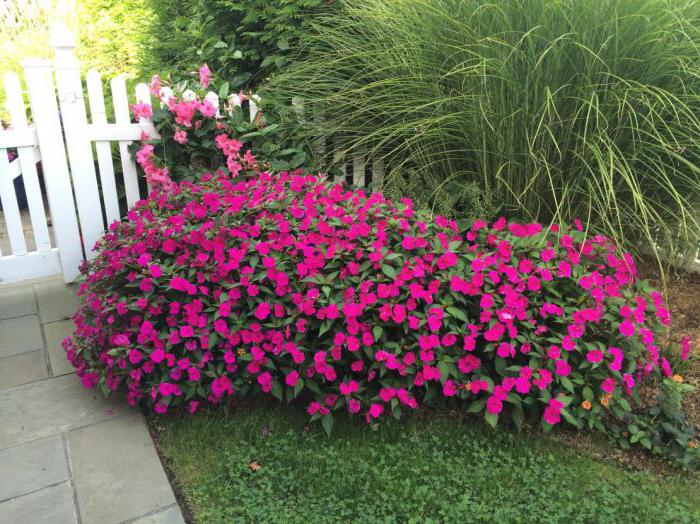

Reproduction of balsam in nature occurs naturally. In culture - from seeds. Ampel balsams can also be diluted with cuttings. The island of Zanzibar is considered the birthplace of this tropical plant. Back in 1596, balsam was brought to Europe, where it quickly gained popularity. The first cultivated species were also bred there. There are three of them: garden balsam, New Guinea and Waller.

